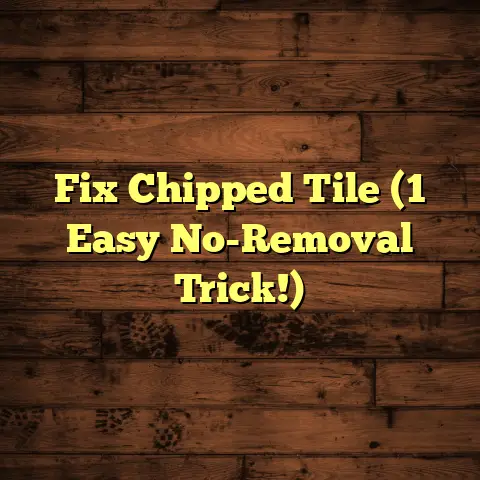Subfloor Install Cost? (2 Pricey Mistakes!)
Ever walked across a floor that felt like
it was about to launch you into orbit?
Or maybe you’ve got that one spot that
sings a squeaky tune every time you pass?
I get it. I’ve been there, seen it all.
Sometimes, a quick fix like shimming or adding a few screws can quiet things down temporarily.
But let’s be real: those are just band-aids.
The real culprit behind uneven, noisy, or even bouncy floors is often hiding underneath: your subfloor.
And trust me, a bad subfloor can cost you way more than just a few squeaks.
That’s why today, we’re diving deep into the world of subfloors.
I’m going to break down the costs of installation and, more importantly, reveal the two HUGE mistakes I see homeowners make all the time that can seriously inflate that bill.
Let’s get started!
Section 1: Understanding Subflooring
So, what is a subfloor, anyway?
Think of it as the unsung hero beneath your beautiful hardwood, tile, or carpet.
It’s the structural layer that sits directly on top of your floor joists and provides a solid, level surface for your finished flooring to be installed.
Without a proper subfloor, your finished floor is basically floating in space, prone to all sorts of problems.
Now, there are a few common types of subfloors you’ll encounter:
Plywood: This is probably the most common.
It’s made of layers of wood veneer glued together, making it strong and relatively stable.
Plywood subflooring typically costs between $0.75 and $2.00 per square foot.OSB (Oriented Strand Board): OSB is another engineered wood product, but it’s made of wood strands glued together.
It’s generally cheaper than plywood, but it can be more susceptible to moisture.
OSB subflooring typically costs between $0.60 and $1.50 per square foot.Concrete: In basements or on slab foundations, the concrete slab itself often serves as the subfloor.
Sometimes, a self-leveling compound is added on top of concrete to create a smoother surface.
The cost of concrete subflooring varies greatly depending on the condition of the existing slab and the need for additional leveling or repair work.
So why is a good subfloor so important?
Well, imagine building a house on a shaky foundation.
Your walls would crack, your doors wouldn’t close properly, and the whole thing would eventually fall apart.
The same principle applies to your flooring.
A solid, level subfloor:
-
Provides a stable base for your finished floor , preventing it from flexing, squeaking, or cracking.
-
Helps to distribute weight evenly, reducing stress on the floor joists.
-
Creates a smooth surface for easier installation of your finished flooring.
-
Can even contribute to the insulation and soundproofing of your room.
Section 2: Overview of Subfloor Installation Costs
Alright, let’s talk money.
How much does subfloor installation actually cost?
Well, it’s not a simple answer, as it depends on a lot of different factors.
But here’s a general breakdown:
Materials: As we discussed earlier, the type of subfloor material you choose will significantly impact the cost.
Plywood will generally be more expensive than OSB, while concrete work can vary widely depending on the scope of the project.Labor: This is where a big chunk of your budget will go, especially if you hire a professional.
Labor costs can range from $2 to $6 per square foot, depending on the complexity of the job, the location, and the experience of the contractor.-
Additional Fees: Don’t forget about things like disposal fees for old flooring, permits (if required), and potentially inspections.
So, let’s put it all together.
For a typical 200-square-foot room, you could expect to pay anywhere from $500 to $2,000 for subfloor installation, depending on the materials and labor involved.
Here’s a table summarizing the costs:
Now, let’s talk about DIY versus hiring a pro.
Can you save money by doing it yourself?
Absolutely!
If you’re handy with tools and have some experience with construction, you can definitely tackle a subfloor installation project.
You’ll save on labor costs, which can be a significant amount.
However, there are risks involved.
If you don’t know what you’re doing, you could end up making mistakes that are costly to fix.
For example, incorrectly installing the subfloor can lead to uneven floors, squeaks, or even structural problems.
Plus, you’ll need to factor in the cost of tools and equipment, which can add up quickly.
Here’s a quick comparison:
Ultimately, the decision of whether to DIY or hire a pro depends on your skill level, budget, and risk tolerance.
If you’re unsure, it’s always best to get a few quotes from reputable contractors and weigh your options carefully.
Section 3: Pricey Mistake #1:
Skipping the Preparation Process
Okay, now let’s get to the good stuff: the mistakes that can really send your subfloor installation costs through the roof.
The first, and perhaps most common, mistake I see is skipping the preparation process.
I can’t stress this enough: proper preparation is absolutely crucial for a successful subfloor installation.
Think of it like this: you wouldn’t build a house on a muddy lot without first grading and leveling the ground, right?
The same principle applies to your subfloor.
Before you even think about laying down new plywood or OSB, you need to take the time to properly prepare the existing surface.
So, what does that entail?
Here are a few key steps:
Removing Old Flooring: This seems obvious, but it’s important to remove all of the old flooring, including any adhesive, nails, or staples.
Leaving old flooring behind can create an uneven surface and prevent the new subfloor from properly adhering to the floor joists.Inspecting the Joists: I always check the floor joists for any signs of damage, such as rot, mold, or insect infestation.
If you find any problems, you’ll need to repair or replace the affected joists before proceeding with the subfloor installation.Leveling the Surface: This is a big one.
If your existing floor is uneven, you’ll need to level it out before installing the new subfloor.
This can be done by using shims, self-leveling compound, or by sanding down high spots.Addressing Moisture Issues: Moisture is the enemy of wood flooring.
Before installing a new subfloor, you need to make sure that the area is dry and free from any leaks or water damage.
This may involve repairing plumbing leaks, improving ventilation, or installing a vapor barrier.
So, what happens if you skip these steps?
Well, let me tell you, it’s not pretty.
Inadequate preparation can lead to a whole host of problems, including:
Uneven Floors: This is the most obvious consequence.
If the subfloor is not level, your finished floor will also be uneven, which can be both unsightly and uncomfortable.Squeaks: Squeaky floors are often caused by the subfloor rubbing against the floor joists.
This can happen if the subfloor is not properly secured or if the joists are uneven.Water Damage: If you install a subfloor over a damp or leaky area, you’re just asking for trouble.
The moisture can cause the wood to rot, mold to grow, and the entire floor to eventually collapse.Structural Instability: In severe cases, inadequate subfloor preparation can even lead to structural problems.
If the subfloor is not properly supported, it can weaken the floor joists and compromise the integrity of your entire floor system.
Trust me, I’ve seen it all.
I’ve seen homeowners who tried to save a few bucks by skipping the prep work, only to end up spending thousands of dollars on repairs down the road.
Don’t make the same mistake.
Take the time to properly prepare the surface before installing your new subfloor, and you’ll save yourself a lot of headaches (and money) in the long run.
Section 4: Pricey Mistake #2:
Choosing the Wrong Materials
Alright, let’s move on to the second major mistake I see homeowners make: choosing the wrong materials for their subfloor.
Now, I know what you’re thinking: “It’s
just a subfloor, right?
How much can the materials really matter?”
Well, let me tell you, they matter a lot.
Choosing the right materials for your subfloor is just as important as choosing the right materials for your finished floor.
After all, the subfloor is the foundation upon which your entire floor system rests.
If you skimp on the materials, you’re setting yourself up for problems down the road.
So, what are some of the key considerations when choosing subfloor materials?
Type of Flooring: The type of flooring you plan to install will influence the type of subfloor you need.
For example, tile requires a more rigid subfloor than carpet.-
Moisture Levels: If you’re installing a subfloor in a damp or humid area, you’ll need to choose materials that are resistant to moisture.
-
Building Codes: Be sure to check your local building codes for any specific requirements regarding subfloor materials.
Now, let’s take a closer look at some of the most common subfloor materials and their pros and cons:
Plywood: As we discussed earlier, plywood is a popular choice for subfloors due to its strength and stability.
However, not all plywood is created equal.
You’ll want to choose a high-quality plywood that is specifically designed for subfloor applications.
Look for plywood that is rated for exterior use and has a thickness of at least 3/4 inch.OSB (Oriented Strand Board): OSB is a cheaper alternative to plywood, but it’s not as strong or moisture-resistant.
If you’re going to use OSB for your subfloor, make sure to choose a high-quality product that is specifically designed for subfloor applications and is rated for exterior use.
I’d recommend plywood over OSB for its superior moisture resistance.Concrete: Concrete is a durable and moisture-resistant option for subfloors, but it can be cold and hard.
If you’re installing a subfloor over concrete, you may want to consider adding a layer of insulation to improve comfort.
So, what happens if you choose the wrong materials for your subfloor?
Well, just like skipping the preparation process, it can lead to a whole host of problems:
Warping: If you use a subfloor material that is not moisture-resistant in a damp area, it can warp and buckle.
This can cause your finished floor to become uneven and can even lead to structural problems.Mold Growth: If moisture gets trapped underneath the subfloor, it can create a breeding ground for mold and mildew.
This can not only damage your floor but can also pose a health hazard.Failure to Comply with Building Codes: Many building codes have specific requirements regarding subfloor materials.
If you choose the wrong materials, you could fail to comply with these codes and be forced to redo the work.
I’ve seen homeowners who tried to save a few bucks by using cheap, low-quality subfloor materials, only to end up regretting it later.
Don’t make the same mistake.
Take the time to research your options and choose the right materials for your specific needs and budget.
It’s an investment that will pay off in the long run.
Section 5: Additional Costs to Consider
Okay, we’ve covered the big ones: skipping the preparation process and choosing the wrong materials.
But there are a few other costs that can arise during subfloor installation that you should be aware of.
Disposal Fees: When you remove your old flooring and subfloor, you’ll need to dispose of the materials properly.
Many landfills charge disposal fees, which can add up depending on the amount of waste.Permits: Depending on your location and the scope of the project, you may need to obtain a building permit before starting your subfloor installation.
Permit fees can vary widely, so be sure to check with your local building department.Inspections: In some cases, you may be required to have your subfloor installation inspected by a building inspector.
Inspection fees can also vary, so be sure to factor this into your budget.Hidden Costs: As with any home improvement project, there’s always the potential for hidden costs to arise.
For example, you may discover unexpected damage to the floor joists or plumbing that needs to be repaired.
It’s always a good idea to add a buffer to your budget to account for these potential unexpected expenses.
I typically recommend adding 10-15% to your estimated costs to cover any surprises.
Section 6: Real-Life Case Studies
Alright, let’s bring this all to life with some real-life examples.
I’m going to share a few case studies of homeowners who faced costly subfloor installation mistakes.
Case Study #1: The Squeaky Nightmare
The Situation: A homeowner decided to install new hardwood floors in their living room.
To save money, they skipped the step of leveling the existing subfloor and simply installed the hardwood directly on top.The Problem: Within a few months, the hardwood floors started to squeak in several areas.
The homeowner tried to fix the problem by adding shims and screws, but the squeaks persisted.The Financial Impact: Eventually, the homeowner had to hire a professional contractor to remove the hardwood floors, level the subfloor, and reinstall the hardwood.
The total cost of the project was more than double what it would have been if they had properly prepared the subfloor in the first place.The Lesson Learned: Don’t skip the preparation process!
Leveling the subfloor is essential for preventing squeaks and ensuring the longevity of your finished floor.
Case Study #2: The Moldy Mess
The Situation: A homeowner decided to install new laminate flooring in their basement.
They chose to use OSB for the subfloor because it was cheaper than plywood.
However, they didn’t realize that their basement had a moisture problem.The Problem: Over time, the OSB subfloor absorbed moisture and started to warp and rot.
Mold also began to grow underneath the laminate flooring.The Financial Impact: The homeowner had to tear out the entire floor, including the laminate and the subfloor.
They also had to hire a mold remediation company to remove the mold.
The total cost of the project was significantly higher than it would have been if they had chosen a more moisture-resistant subfloor material.The Lesson Learned: Choose the right materials for your specific environment.
If you’re installing a subfloor in a damp or humid area, be sure to use moisture-resistant materials.
Case Study #3: The Code Violation
The Situation: A homeowner decided to install a new tile floor in their bathroom.
They used a thin, flexible plywood for the subfloor, thinking it would be sufficient.The Problem: During the inspection, the building inspector determined that the plywood was not thick enough to support the weight of the tile.
The homeowner was forced to tear out the existing subfloor and install a thicker, more rigid subfloor that complied with building codes.The Financial Impact: The homeowner had to pay for the cost of removing the existing subfloor, purchasing new materials, and reinstalling the subfloor.
They also had to pay for a second inspection.The Lesson Learned: Always check your local building codes before starting any home improvement project.
Make sure that the materials you choose comply with all applicable codes and regulations.
These case studies highlight the importance of proper planning, preparation, and material selection when it comes to subfloor installation.
By learning from the mistakes of others, you can avoid costly pitfalls and ensure a successful project.
Section 7: Conclusion
Alright, we’ve covered a lot of ground today.
Let’s recap the key takeaways:
-
Subfloor installation is a critical component of any flooring project.
-
The cost of subfloor installation can vary depending on the materials, labor, and other factors.
-
There are two major mistakes that can significantly increase the cost of subfloor installation: skipping the preparation process and choosing the wrong materials.
-
Proper preparation involves removing old flooring, inspecting the joists, leveling the surface, and addressing moisture issues.
-
Choosing the right materials involves considering the type of flooring, moisture levels, and building codes.
-
Additional costs to consider include disposal fees, permits, inspections, and potential hidden costs.
-
Learning from real-life case studies can help you avoid costly mistakes.
Ultimately, investing in proper subfloor installation and materials can save you money in the long run and provide you with a beautiful, durable, and comfortable floor for years to come.
Don’t cut corners on your subfloor.
It’s the foundation of your entire floor system, and it’s worth doing right.
Thanks for reading, and happy flooring!





